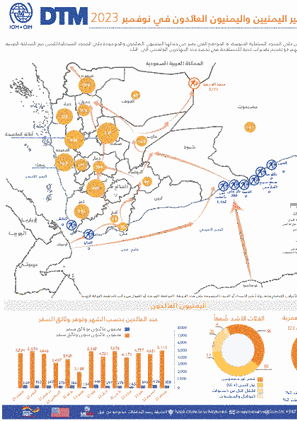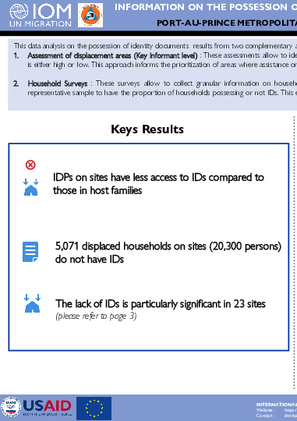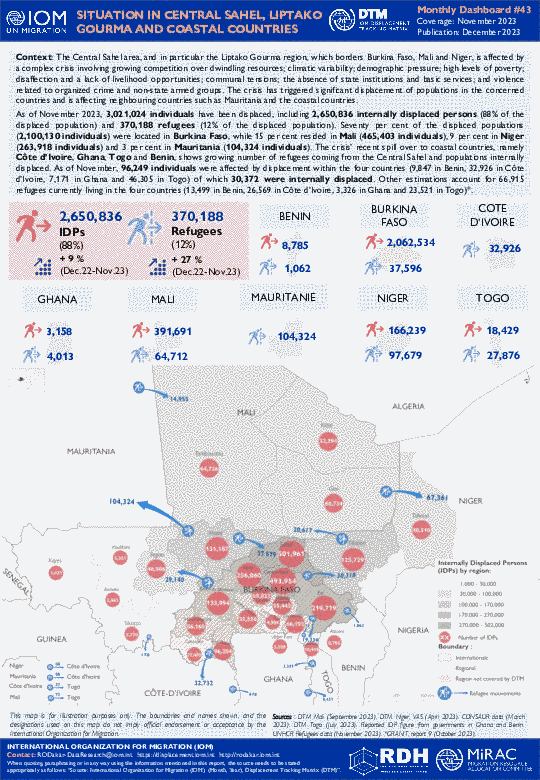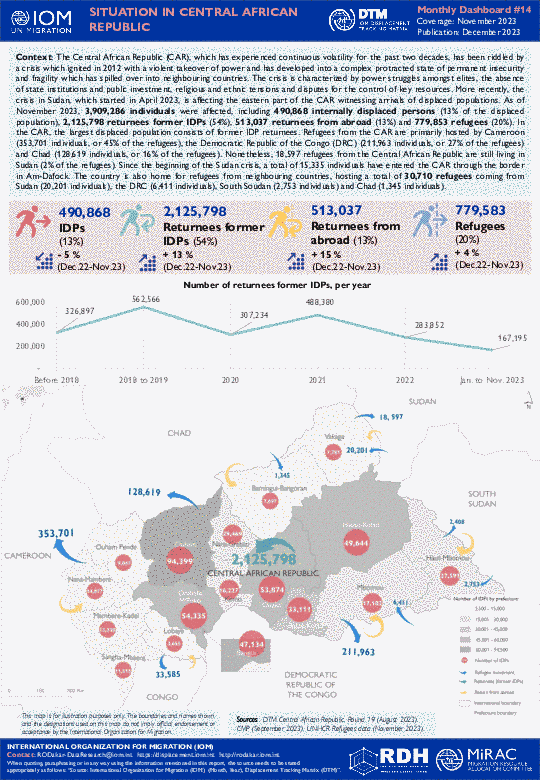-
Countries
-
Data and Analysis
-
Special Focus
-
Crisis Responses

Contact
DTM Yemen, iomyemendtm@iom.int
Language
English
Location
Yemen
Period Covered
Nov 01 2023
Nov 30 2023
Activity
- Flow Monitoring
- Mobility Tracking
- Baseline Assessment
عمل مصفوفة تتبُع النزوح الخاصة بالمنظمة الدولية للهجرة في اليمن عبر سجل مراقبة التدفق في المواقع الرئيسية التي يصل عبرها المهاجرون على الحدود الساحلية الجنوبية، و المواقع التي يعبر من خلالها اليمنيون العائدون والموجودة على الحدود الشمالية لليمن مع المملكة العربية السعودية. يُراقب الباحثون المتمركزون في نقاط رصد تدفق وصول المهاجرين والمواطنين اليمنيين العائدين من أجل التعرف على الأنماط المختلفة للهجرة وتقديم تقديرات كمية للمساهمة في تحديد عدد المهاجرين الوافدين الى البلد.
لا يشمل سجل مراقبة التدفق جميع نقاط التدفق في اليمن، ولكنه يمثل مؤشراً حول اتجاهات الهجرة بالنسبة لإجمالي العدد غير المعروف للمهاجرين الوافدين إلى اليمن عبر نقاط التدفق خلال الإطار الزمني المحدد. والجدير بالذكر أن القيود المفروضة على الوصول تَحُد من القدرة على جمع البيانات في بعض نقاط وصول المهاجرين.
في نوفمبر 2023، سجلت مصفوفة تتبع النزوح التابعة للمنظمة الدولية للهجرة في اليمن دخول 1,465 مهاجرًا إلى اليمن، بزيادة قدرها 25 بالمائة مقارنة بالشهر الماضي (1,169). منذ أن بدأت الحملة العسكرية المشتركة قبل أربعة أشهر، انخفض عدد المهاجرين الذين يدخلون اليمن عبر ساحل لحج بشكل مطرد. وفي أغسطس (2,249) وسبتمبر (548)، أبلغت الفرق الميدانية عن انخفاضات ملحوظة، واستمر هذا الاتجاه في أكتوبر ونوفمبر عندما لم يتم تسجيل أي وصول للمهاجرين إلى اليمن عبر ساحل لحج. وانتشرت خلال الحملة قوات عسكرية على طول الشريط الساحلي لملاحقة قوارب المهربين، واعتقال المهربين الذين ساعدوا في نقل المهاجرين، ومداهمة ممتلكاتهم. ولا تزال الحملة مستمرة في محافظة لحج التي كانت تستقبل عددًا كبيرًا من المهاجرين من جيبوتي قبل أغسطس 2023 (بحد أقصى في مارس 15,714 مهاجرًا). كما استؤنفت عمليات الوصول من جيبوتي في نوفمبر2023، لكن هؤلاء المهاجرين (400 مهاجر) لم يمروا إلا من لحج على الساحل اليمني إلى شبوة (على بعد حوالي 450 كيلومتراً)، والتي استقبلت حتى الآن في الغالب أولئك الذين يغادرون من الساحل الصومالي. ارتفع العدد الإجمالي للمهاجرين الذين يدخلون عبر شبوة الأقرب إلى الساحل الصومالي بنسبة 25 في المائة في نوفمبر (1,465) مقارنة بشهر أكتوبر (1,169). ويمكن ربط الزيادة الإجمالية بالظروف الجوية والمد والجزر وكذلك التغير في الطرق. ووفقًا لمصفوفة تتبع النزوح، شكلت الحركات الناجمة عن النزاع 61 في المائة من جميع الحركات الواردة في نوفمبر 2023. وقد لوحظت هذه الحركات حصريًا في شبوة، قادمة من باري، الصومال (55٪) وأوبوك، جيبوتي (45٪) (20٪ أطفال، 19% نساء، و61% رجال).
أدت الأزمة الإنسانية في اليمن وتحديات الوصول إلى المملكة العربية السعودية إلى عودة العديد من المهاجرين إلى القرن الأفريقي. في نوفمبر 2023، سجل فريق مصفوفة تتبع النزوح في جيبوتي 505 مهاجرين (424 ذكرًا و81 أنثى) انطلقوا في رحلة خطيرة للعودة إلى وطنهم بالقارب من اليمن. بالإضافة إلى ذلك، لاحظت مصفوفة تتبع النزوح انخفاضًا في عدد العائدين اليمنيين بنسبة خمسة بالمائة في نوفمبر (1,465) مقارنة بشهر أكتوبر (1,169). بين يناير ونوفمبر 2023، سجلت مصفوفة تتبع النزوح إجمالي 94,991 مهاجرًا و50,575 مهاجرًا يمنيًا عائدًا إلى اليمن. علاوة على ذلك، في سبتمبر 2023، تم ترحيل 152 مهاجرًا من عمان. وفي أكتوبر، ارتفع هذا الرقم إلى 254 مهاجراً قبل أن ينخفض إلى صفر في نوفمبر بسبب القيود المفروضة حديثاً على المرحلين على الجانب اليمني من الحدود.

Contact
DTM Yemen, iomyemendtm@iom.int
Language
English
Location
Yemen
Period Covered
Nov 01 2023
Nov 30 2023
Activity
- Flow Monitoring
- Mobility Tracking
- Baseline Assessment
IOM Yemen DTM’s Flow Monitoring Registry (FMR) monitors migrant arrivals on the southern coastal border and Yemeni return locations on Yemen's northern border with the Kingdom of Saudi Arabia (KSA). Enumerators placed at Flow Monitoring Points (FMPs) record migrant arrivals and returning Yemeni nationals to identify different patterns of migration, and to provide quantitative estimates to help define the population of irregular migrants entering the country. FMR is not representative of all flows in Yemen and should be understood as only indicative of migration trends of the unknown total number of migrants arriving in Yemen at FMPs during the time frame indicated. Access constraints limit the ability to collect data at some migrant arrival points.
In November 2023, IOM Yemen DTM recorded 1,465 migrants entering Yemen, an increase of 25 per cent compared to last month (1,169). Since the joint military campaign began four months ago, the number of migrants entering Yemen through the coast of Lahj has been steadily decreasing. In August (2,249) and September (548), field teams reported notable decreases, and this trend continued into October and November when no migrant arrivals to Yemen through the Lahj coast were recorded. During the campaign, military along the coastal strip were deployed to pursue smugglers’ boats, arrest smugglers who assisted in transporting migrants, and raid their properties. The campaign is still ongoing in Lahj governorate which used to receive high number of migrants from Djibouti before August 2023 (max. in March with 15,714 migrants).
Arrivals from Djibouti have recommenced in November – however, these migrants (400) exclusively travelled past Lahj along the Yemeni coast to Shabwah (approx. 450km), which mostly received persons departing from the Somali coast up to date.
The overall number of migrants entering through Shabwah closer to the Somali coast has increased by 25 per cent in November (1,465) compared to October (1,169). The overall increase could be linked to weather conditions and sea tides as well as the change in routes.
According to DTM, conflict-induced movements constituted 61 per cent of all incoming movements in November 2023. These movements were exclusively observed in Shabwah, originating from Bari, Somalia (55%) and Obock, Djibouti (45%) (20% children, 19% women, and 61% men).
The humanitarian crisis in Yemen and challenges in reaching Saudi Arabia led many migrants to return to the Horn of Africa. In November 2023, Djibouti DTM team recorded 505 migrants (424 male and 81 female) embarked on a dangerous journey back home by boat from Yemen. Additionally, DTM observed a decrease in Yemeni returnees by five per cent in November (1,465) compared to October (1,169). Between January and November 2023, DTM recorded a total of 94,991 migrants and 50,575 Yemeni migrant returnees to Yemen. Furthermore, in September 2023, 152 migrants were deported from Oman. In October this figure rose to 254 migrants before dropping to 0 in November due to newly imposed restrictions on deportees by the Yemeni side of the border.

Contact
dtmhaiti@iom.int
Language
English
Location
Haiti
Period Covered
Dec 02 2023
Dec 08 2023
Activity
- Mobility Tracking
- Event Tracking
Since the beginning of December, armed clashes have broken out in the neighborhoods of Bon repos - Lizon, Galette - Roche Blanche, Meyer and Guedon located in the municipality of Croix-des-Bouquets. In addition to loss of life, these attacks have also caused the displacement of approximatively 567 individuals (158 households). Most of displaced persons (78%) took refuge in host families and 22% in two newly created sites in the municipalities of Tabarre and Delmas

Contact
DTM Haiti, dtmhaiti@iom.int
Language
English
Location
Haiti
Period Covered
Oct 09 2023
Oct 20 2023
Activity
- Survey
- Mobility Tracking
- Site Assessment
- Baseline Assessment
- Village Assessment
This data analysis on the possession of identity documents results from two complementary approaches: 1. Assessment of displacement areas (Key Informant level) : These assessments allow to identify areas (host families and displacement sites) where the possession of identity documents (IDs) is either high or low. This approach informs the prioritization of areas where assistance on IDs’ issuance is most needed. 2. Household Surveys : These surveys allow to collect granular information on household level. Whereas the first methodology informs prioritization of areas, surveys allow from a representative sample to have the proportion of households possessing or not IDs. This eventually allowing to define the number of potential beneficiaries of assistance of IDs' issuance.
Results indicate that IDPs on sites have less access to IDs compared to those in host families, 5,071 displaced households on sites (20,300 persons) do not have IDs, the lack of IDs is particularly significant in 23 sites
The Central Sahel area, and in particular the Liptako Gourma region, which borders Burkina Faso, Mali and Niger, is affected by a complex crisis involving growing competition over dwindling resources; climatic variability; demographic pressure; high levels of poverty; disaffection and a lack of livelihood opportunities; communal tensions; the absence of state institutions and basic services; and violence related to organized crime and non-state armed groups. The crisis has triggered significant displacement of populations in the concerned countries and is affecting neighbouring countries such as Mauritania and the coastal countries.
As of November 2023, 3,021,024 individuals have been displaced, including 2,650,836 internally displaced persons (88% of the displaced population) and 370,188 refugees (12% of the displaced population). Seventy per cent of the displaced populations (2,100,130 individuals) were located in Burkina Faso, while 15 per cent resided in Mali (465,403 individuals), 9 per cent in Niger (263,918 individuals) and 3 per cent in Mauritania (104,324 individuals). The crisis’ recent spill over to coastal countries, namely Côte d’Ivoire, Ghana, Togo and Benin, shows growing number of refugees coming from the Central Sahel and populations internally displaced. As of November, 96,249 individuals were affected by displacement within the four countries (9,847 in Benin, 32,926 in Côte d’Ivoire, 7,171 in Ghana and 46,305 in Togo) of which 30,372 were internally displaced.
Contact
dtmlebanon@iom.int
Location
Lebanon
Activity
- Mobility Tracking
- Baseline Assessment
Period Covered
Oct 10 2023 -Dec 05 2023
Since October 8 there has been an increase in cross-border incidents between Israel and Lebanon, resulting in the displacement of people both within the South and elsewhere within the country. Since October 10, the Displacement Tracking Matrix (DTM) has been conducting the daily monitoring of population movements. The objective of the exercise is to inform preparedness and response planning.
Population Groups
IDPs
Survey Methodology
Unit of Analysis Or Observation
Admin Area 2
Admin Area 3
Household
Individual
Type of Survey or Assessment
Key Informant
Keywords
Geographical Scope Full Coverage
Administrative boundaries with available data
The current dataset covers the following administrative boundaries
The Central African Republic (CAR), which has experienced continuous volatility for the past two decades, has been riddled by a crisis which ignited in 2012 with a violent takeover of power and has developed into a complex protracted state of permanent insecurity and fragility which has spilled over into neighbouring countries. The crisis is characterized by power struggles amongst elites, the absence of state institutions and public investment, religious and ethnic tensions and disputes for the control of key resources. More recently, the crisis in Sudan, which started in April 2023, is affecting the eastern part of the CAR witnessing arrivals of displaced populations.
As of November 2023, 3,909,286 individuals were affected, including 490,868 internally displaced persons (13% of the displaced population), 2,125,798 returnees former IDPs (54%), 513,037 returnees from abroad (13%) and 779,853 refugees (20%). In the CAR, the largest displaced population consists of former IDP returnees. Refugees from the CAR are primarily hosted by Cameroon (353,701 individuals, or 45% of the refugees), the Democratic Republic of the Congo (DRC) (211,963 individuals, or 27% of the refugees) and Chad (128,619 individuals, or 16% of the refugees). Nonetheless, 18,597 refugees from the Central African Republic are still living in Sudan (2% of the refugees). Since the beginning of the Sudan crisis, a total of 15,335 individuals have entered the CAR through the border in Am-Dafock. The country is also home for refugees from neighbouring countries, hosting a total of 30,710 refugees coming from Sudan (20,201 individuals), the DRC (6,411 individuals), South Soudan (2,753 individuals) and Chad (1,345 individuals).
In Central America, North America and the Caribbean, large migratory movements emerge and flow. According to migration data from the government of Panama, between July and December 2022, at least 198,832 migrants entered Panama through the Darien route. During the same period in 2021, 107,510 people entered, representing an 85 per cent increase.
From July to December 2022, IOM's Displacement Tracking Matrix (DTM) collected primary data in more than 40 locations in the Region. DTM is a system to collect and analyze primary data, to disseminate critical information on the mobility, vulnerabilities and needs of displaced and mobile populations, for decision making and to provide context-specific assistance. Between July and December 2022, DTM activities were carried out by eight countries in the region, through the implementation of different DTM components including mobility tracking of IDPs, flow monitoring registry and surveys, as well as surveys to people on the move and returnees.
This report aims to provide an overview of migration movements in the region, including the locations and months in which primary data were collected through DTM instruments.

Contact
DTM Nigeria, iomnigeriadtm@iom.int
Language
English
Location
Nigeria
Snapshot Date
Nov 30 2023
Activity
- Registration
- Biometric Registration
Six LGAs have been mapped as locations with IDPs in Benue State based on DTM Round 11 (March 2023). So far, the biometrically registered IDPs have covered the location of Makurdi LGA (5 camps and 2 host community sites), Guma LGA (2 camps and two host community sites), Logo LGA (2 camps and 2 host community sites), Kwande (1 camp and 1 host community site) and currently ongoing in Agatu LGA (2 host community sites).
The registration has shown that Guma LGA has the highest number of IDPs, with 23,283 individuals (6,750 households), followed by Kwande with 15,934 individuals (3,232 households), then Makurdi with 14,041 individuals (4,150 households). Logo had 13,632 individuals (3,314 households). The registration is ongoing in Agatu LGA, with 21,895 registered individuals (5,649 households).
During the registration, 10,191 individuals were identified with vulnerabilities and specific needs (including but not limited to serious medical illness) and have been referred to UNHCR/FJDP for further support. All registered IDPs have received biometric cards with unique numbers for easy identification. The registration is an ongoing process.

Contact
DTMUkraine@iom.int
Language
English
Location
Ukraine
Period Covered
Sep 03 2023
Sep 25 2023
Activity
- Survey
З 3 по 25 вересня 2023 року Міжнародна організація з міграції (МОМ) провела 14-й раунд Загального обстеження населення (ОГН) - високорепрезентативної оцінки внутрішнього переміщення в Україні, яка збирає інформацію про чисельність населення, потоки мобільності, наміри та умови, щоб сприяти прийняттю обґрунтованих рішень щодо стратегічних, технічних і програмних аспектів реагування та відновлення в Україні. Крім того, 14-й раунд продовжує оцінювати довгострокові рішення щодо внутрішнього переміщення відповідно до критеріїв, запропонованих Рамковою програмою Міжвідомчого постійного комітету з питань довгострокових рішень для ВПО (МПК). Цей звіт також містить нові розділи, присвячені підготовці до зими та участі у суспільних справах. Загальне опитування населення було проведене шляхом інтерв'ю з 20 000 респондентів за допомогою комп'ютеризованого телефонного інтерв'ю (CATI) та методу випадкового набору номера (RDD).


